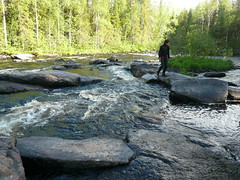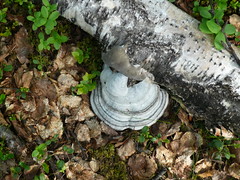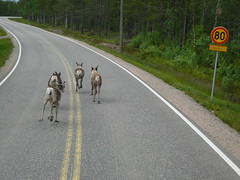There are several different ways that the location of the Arctic is determined. The first is what is known as the Arctic Circle, or the latitude of 66 degrees North. By some accounts, everything above that latitude is considered the Arctic. However, others prefer to use the tree line to designate the Arctic. This is of course a much less regular line marking where the trees cease to grow.
My encounter with the Arctic Circle was in Rovaniemi, a town famous as the home of Santa Claus (every Finnish child knows that his workshop is hidden in one of several round hills, called fells, surrounding Rovaniemi) and for its location at the very edge of the Arctic Circle.
Rovaniemi, however, is most certainly not at the tree line, it has dense pine forests. I went to one exactly on the Arctic Circle on the day of the midnight sun, the day with the most sunlight of the year celebrated in Scandinavia traditionally with drinking, dancing and staying up all night. I was part of the InSea conference, an organization that brings international artists and educators together in a different location each year according to a theme. The theme this year was sustainability in art education, and was fittingly held in a place facing some of the greatest challenges due to global climate change. InSea sponsored a sound, smell and touch walk through the Arctic Circle park.
 Touch walk in the Arctic Circle Park
Of course I was already very familiar with the soundwalking process, I've been leading them for several years now in conjunction with the New York Society for Acoustic Ecology (NYSAE) and American Society for Acoustic Ecology (ASAE), and had traveled to Rovaniemi directly from Koli in the Karelia area of Finland where the Finnish counterpart to the ASAE has holding the World Forum for Acoustic Ecology's conference, Ideologies and Ethics in the Uses and Abuses of Sound and I had participated in some soundwalks there. However, the smell and touch walk was something new to me. Unfortunately, it wasn't possible to smell anything in the forest except the intensely strong mosquito repellent we were all forced to slather on our bodies or be eaten alive, but the touch walk was extremely moving.
Touch walk in the Arctic Circle Park
Of course I was already very familiar with the soundwalking process, I've been leading them for several years now in conjunction with the New York Society for Acoustic Ecology (NYSAE) and American Society for Acoustic Ecology (ASAE), and had traveled to Rovaniemi directly from Koli in the Karelia area of Finland where the Finnish counterpart to the ASAE has holding the World Forum for Acoustic Ecology's conference, Ideologies and Ethics in the Uses and Abuses of Sound and I had participated in some soundwalks there. However, the smell and touch walk was something new to me. Unfortunately, it wasn't possible to smell anything in the forest except the intensely strong mosquito repellent we were all forced to slather on our bodies or be eaten alive, but the touch walk was extremely moving.
 On the touch walk
We were asked to touch as many objects in the forest as we could, with our hands but also with our feet, legs, and faces. At first this exercise was surprising, as each object I touched seemed to have an unexpected texture, temperature and level of moisture. Then the process seemed to awaken a more intense sensory experience, and a kind of empathy for the living things in the forest. It became very clear how young the plants were, and I and others in our group thought of them as children. Their fragility was also striking, and it took some time to adjust the amount of force to touch without breaking the plant.
On the touch walk
We were asked to touch as many objects in the forest as we could, with our hands but also with our feet, legs, and faces. At first this exercise was surprising, as each object I touched seemed to have an unexpected texture, temperature and level of moisture. Then the process seemed to awaken a more intense sensory experience, and a kind of empathy for the living things in the forest. It became very clear how young the plants were, and I and others in our group thought of them as children. Their fragility was also striking, and it took some time to adjust the amount of force to touch without breaking the plant.
 Reindeer on the road to Kilpisjarvi
After Rovaniemi, I took a bus to Kilpisjarvi. Most of the way we drove north along a river that divides Finland and Sweden. Despite that fact that Sweden was a stone's throw away, bridges are rare and it is much more common to take a boat to the small Swedish towns, or in winter to drive a car over the frozen river. When we began to approach the tree line, the pine trees became noticeably smaller, and finally, the landscape changed dramatically. Low birch trees, twisted like bonsais, sparsely dotted the landscape and rolling hills were transformed into dramatic mountains with patches of snow. Even this is not yet the official tree line designating the Arctic, which is the point at which the temperature is so low that no trees can survive, but is known as a sub-Arctic climate. Throughout the Kilpisjarvi area, there are Arctic conditions present in higher elevations and you can actually see the line where trees and other vegetation disappears.
Reindeer on the road to Kilpisjarvi
After Rovaniemi, I took a bus to Kilpisjarvi. Most of the way we drove north along a river that divides Finland and Sweden. Despite that fact that Sweden was a stone's throw away, bridges are rare and it is much more common to take a boat to the small Swedish towns, or in winter to drive a car over the frozen river. When we began to approach the tree line, the pine trees became noticeably smaller, and finally, the landscape changed dramatically. Low birch trees, twisted like bonsais, sparsely dotted the landscape and rolling hills were transformed into dramatic mountains with patches of snow. Even this is not yet the official tree line designating the Arctic, which is the point at which the temperature is so low that no trees can survive, but is known as a sub-Arctic climate. Throughout the Kilpisjarvi area, there are Arctic conditions present in higher elevations and you can actually see the line where trees and other vegetation disappears.
